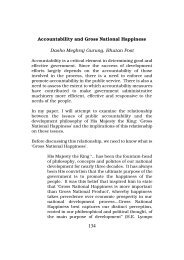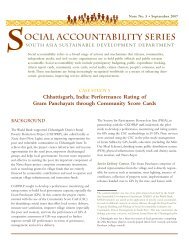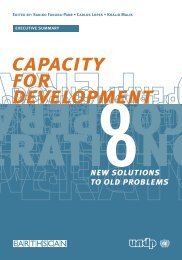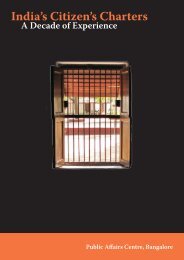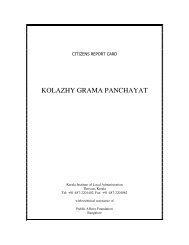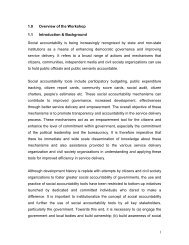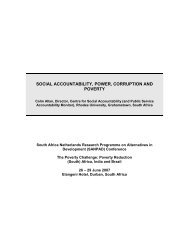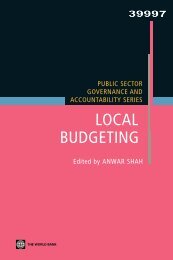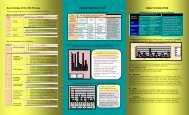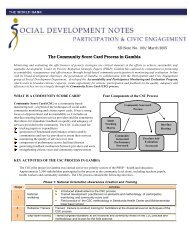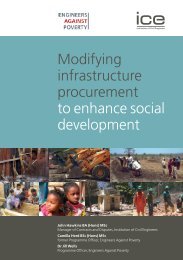Enabling Environment for Social Accountability in ... - SASANet
Enabling Environment for Social Accountability in ... - SASANet
Enabling Environment for Social Accountability in ... - SASANet
You also want an ePaper? Increase the reach of your titles
YUMPU automatically turns print PDFs into web optimized ePapers that Google loves.
Annex 3: <strong>Social</strong> <strong>Accountability</strong> and <strong>Environment</strong>al Protection:<br />
The Ongi River Movement 72<br />
THE BIRTH, GROWTH, AND MISSION OF A COMMUNITY-BASED ORGANIZATION<br />
The Ongi River Movement began <strong>in</strong> 2001 <strong>in</strong> response to the environmental degradation of the Ongi River<br />
System <strong>in</strong> central Mongolia. The river system orig<strong>in</strong>ally spanned more than 435 kilometers from the<br />
Khangai Mounta<strong>in</strong>s through the Khangai Steppe <strong>in</strong>to the Gobi Desert, and fed <strong>in</strong>to Ulaan (“Red”) Lake,<br />
which covered an area of 175 square kilometers. Historically, the Ongi susta<strong>in</strong>ed the lives of more than<br />
100,000 people and more than 1 million livestock (TAF 2004c). The Ongi now flows only 100<br />
kilometers, less than a quarter of its natural length, whereas the lake had completely dried up by 1995. 73<br />
As Mongolia depends largely on surface water (70 percent of its water reserves), the depletion of this<br />
river system has serious implications <strong>for</strong> the region. It has led to a shortage of dr<strong>in</strong>k<strong>in</strong>g water <strong>for</strong> more<br />
than 57,000 people and their animals. As a result pastoralists have been <strong>for</strong>ced to herd their livestock <strong>in</strong><br />
other aimags, caus<strong>in</strong>g serious problems <strong>for</strong> pastureland management <strong>in</strong> other regions as well.<br />
The driv<strong>in</strong>g <strong>for</strong>ce beh<strong>in</strong>d the movement was the chair of the Citizen Representative Khural <strong>in</strong> the<br />
Saikhan-Ovoo soum. In 2001, he gathered residents of eight soums from the three neighbor<strong>in</strong>g aimags<br />
through which the Ongi flows <strong>in</strong> a shared mission to reverse the dry<strong>in</strong>g up of the Ongi River System and<br />
restore Ulaan Lake. 74 Initially he gathered several dozen people to discuss the matter. This was followed<br />
by a broader campaign that drew governors, leaders of other local khurals, and ord<strong>in</strong>ary citizens from all<br />
eight soums to a meet<strong>in</strong>g later that year. Local soum governments committed a total of MT 100,000 to<br />
support the emerg<strong>in</strong>g movement, which then registered with the M<strong>in</strong>istry of Justice and Home Affairs as<br />
a nongovernmental organization. Today, ORM is at once a community-based organization and part of a<br />
grow<strong>in</strong>g environmental movement with broad appeal beyond its region.<br />
The chair of the ORM has held his post s<strong>in</strong>ce his election <strong>in</strong> 2001. In addition to the chair, the<br />
organization has four other paid staff positions: an executive director, a manager, a program officer, and a<br />
driver. ORM’s home base rema<strong>in</strong>s Saikhan-Ovoo soum. It is headed by the executive director who served<br />
as a volunteer until the end of 2004. In this and the seven other soums where the ORM operates, there are<br />
a total of eight branch offices run by volunteers. The organization also has a small, one-room liaison<br />
office <strong>in</strong> Ulaanbaatar to facilitate public campaigns, advocacy, policy dialogue, and fundrais<strong>in</strong>g. The chair<br />
operates from this office but commutes frequently to the river bas<strong>in</strong>. The movement further benefits from<br />
assistance from the director of the Center <strong>for</strong> Land, Forest and Water Resource Management at the<br />
Mongolian State Agriculture University, who acts as both an adviser and researcher <strong>for</strong> ORM on a pro<br />
bono basis.<br />
Over the last four years, ORM has expanded its objectives to achieve its <strong>in</strong>itial mission to revive the Ongi<br />
River Bas<strong>in</strong>. As part of its ef<strong>for</strong>ts to promote the restoration and rehabilitation of the Ongi River System,<br />
its 2004 program <strong>in</strong>cluded several other objectives: 1) susta<strong>in</strong>able community-based organizations that<br />
care <strong>for</strong> the environment; 2) <strong>in</strong><strong>for</strong>med and committed local citizens who monitor and protect the<br />
environment; 3) transparent local government structures that ensure a healthy environment; and 4) an<br />
<strong>in</strong>teractive relationship between local governments and CBOs that cooperate with and support each other.<br />
72 Research <strong>for</strong> this case study was conducted primarily by Jeff Th<strong>in</strong>dwa, Senior <strong>Social</strong> Development Specialist, World Bank.<br />
73 In Saikhan Ovoo, <strong>for</strong> example, the river no longer runs, although a World Water Action report recorded its water flow at 1.8<br />
cubic meters per second <strong>in</strong> 1950.<br />
74 The three aimags <strong>in</strong> which the ORM works are Uvorkhangai, Umnigobi, and Dundgobi; the eight soums are Uyanga,<br />
Zuunbayan-Ulaan, Taragt, Arvakheer, Bayangol, Saikhan-Ovoo, Bulgan, and Mandal-Ovoo.<br />
75




